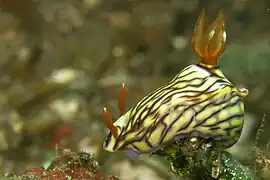Hypselodoris nigrostriata
Hypselodoris nigrostriata is a species of sea slug or dorid nudibranch, a marine gastropod mollusk in the family Chromodorididae.[2]
| Hypselodoris nigrostriata | |
|---|---|
 | |
| Scientific classification | |
| Domain: | Eukaryota |
| Kingdom: | Animalia |
| Phylum: | Mollusca |
| Class: | Gastropoda |
| Subclass: | Heterobranchia |
| Order: | Nudibranchia |
| Suborder: | Doridina |
| Superfamily: | Doridoidea |
| Family: | Chromodorididae |
| Genus: | Hypselodoris |
| Species: | H. nigrostriata |
| Binomial name | |
| Hypselodoris nigrostriata (Eliot, 1904)[1] | |
| Synonyms | |
| |
Distribution
This nudibranch is found in the Western Indian Ocean, from Tanzania to the Red Sea.[3]
Description
Hypselodoris nigrostriata has a yellow body with black striated lines running all over the body and upper dorsum. The gills and rhinophores are orange-red. This species can reach a total length of at least 40 mm and feeds on blue sponges from the genus Dysidea.[3][4][5][6] It has a similar colour pattern to Hypselodoris zephyra from the western Indo-Pacific Ocean.[7]
References
- Eliot, C. N. E. (1904). On some nudibranchs from East Africa and Zanzibar, part IV. Proceedings of the Zoological Society of London. 1904:1:380, p. 394
- MolluscaBase (2018). Hypselodoris nigrostriata (Eliot, 1904). Accessed on 2019-01-18
- Rudman, W.B., 1999 (March 21) Hypselodoris nigrostriata (Eliot, 1904). [In] Sea Slug Forum. Australian Museum, Sydney.
- Rudman, W.B. (1977) Chromodorid opisthobranch Mollusca from East Africa and the tropical West Pacific. Zoological Journal of the Linnean Society 61: 351-397
- Rudman W.B. (1984) The Chromodorididae (Opisthobranchia: Mollusca) of the Indo-West Pacific: a review of the genera. Zoological Journal of the Linnean Society 81 (2/3): 115-273. page(s): 189
- Debelius, H. & Kuiter, R.H. (2007) Nudibranchs of the world. ConchBooks, Frankfurt, 360 pp. ISBN 978-3-939767-06-0 page(s): 124
- Gosliner, T.M., Behrens, D.W. & Valdés, Á. (2008) Indo-Pacific Nudibranchs and seaslugs. A field guide to the world's most diverse fauna. Sea Challengers Natural History Books, Washington, 426 pp. page(s): 266
This article is issued from Wikipedia. The text is licensed under Creative Commons - Attribution - Sharealike. Additional terms may apply for the media files.